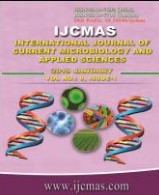


 National Academy of Agricultural Sciences (NAAS)
National Academy of Agricultural Sciences (NAAS)

|
PRINT ISSN : 2319-7692
Online ISSN : 2319-7706 Issues : 12 per year Publisher : Excellent Publishers Email : editorijcmas@gmail.com / submit@ijcmas.com Editor-in-chief: Dr.M.Prakash Index Copernicus ICV 2018: 95.39 NAAS RATING 2020: 5.38 |
The aims of this study were to assess regional disparity in anemic status and to identify the sociodemographic factors associated with the prevalence of anemia among school-children from Punjab, India. A school-based cross-sectional study was conducted on 210 children (11-17y) randomly selected from government schools of three regions of Punjab, namely Majha (n=45), Doaba (n=45) and Malwa (n=120). Data on sociodemographic characteristics and dietary intake of children were collected through questionnaire based survey. Information on clinical signs/symptoms of anemia and compliance to iron-folic acid supplementation was obtained. Hemoglobin concentration was estimated by cyanmethaemoglobin method. Data were analyzed by Tukey's post-hoc test and Fisher’s exact test using SPSS version 23.0. Overall, children’s diets were highly inadequate in iron, i.e., less than 43% of the recommended dietary allowances. Clinical examination showed more than half of the subjects exhibiting signs/symptoms of anemia. Compliance to iron-folic acid supplementation was 100% in Majha region subjects, while, it was 93 and 77% in Doaba and Malwa region subjects, respectively. Anemia prevalence was 91, 98 and 100%, among school-children of Majha, Malwa and Doaba region, respectively. Mean hemoglobin level of the subjects from Majha region (10.7g/dl) was statistically significantly (p=0.029) higher than Doaba region (10.4 g/dl) and non-significantly higher than Malwa region subjects (10.4g/dl); however, the age and gender specific mean hemoglobin values of all the subjects was lower than the reference values for their corresponding age groups. In Majha region, caste (p=0.02) and family income (p=0.01) were found significantly associated with anemia. The study finds anemia as a severe public health problem among school-children of Punjab. This paper fulfills an identified need to undertake more studies considering regional variations across the states, in order to obtain a clearer picture on magnitude of the problem, causes and factors associated with anemia.
 |
 |
 |
 |
 |